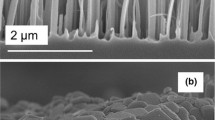2
/p-Si MOS structures were prepared in 0.1 M K2SO4 electrolyte with a pH of 7 (the 0.1 M KOH solution was buffered with H2SO4) at current densities of 3, 5, and 7 mA/cm2 and with four different pH values of the electrolyte at 3 mA/cm2. It is found that thermal annealing at a relatively low temperature can be used to improve the anodic MOS characteristics. Moreover, of the pH and current density it followed that the pH has a dominant role in the interface electrical properties. The lowest interface state densities at the maximum and the midgap positions are 7.1×1011 and 2.7×1010 eV-1cm-2 for a sample made with pH=7, J=3 mA/cm2. The characteristics of this sample seem satisfactory for device applications of anodized p-Si.
Similar content being viewed by others
Author information
Authors and Affiliations
Additional information
Received: 8 July 1996/Accepted: 22 January 1997
Rights and permissions
About this article
Cite this article
Saglam, M., Türüt, A., Nuhoglu, Ç. et al. Influences of thermal annealing, the electrolyte pH, and current density on the interface state density distribution of anodic MOS structures . Appl Phys A 65, 33–37 (1997). https://doi.org/10.1007/s003390050537
Issue Date:
DOI: https://doi.org/10.1007/s003390050537



